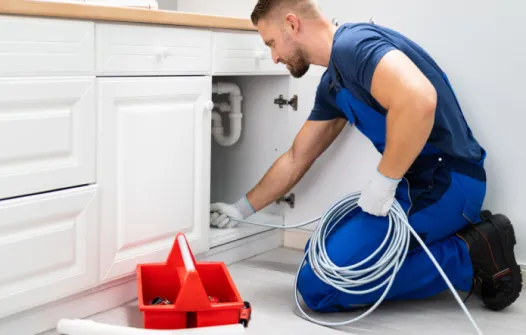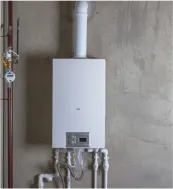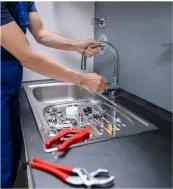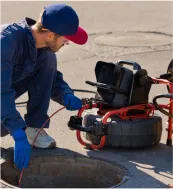

How to Increase Water Pressure
Low water pressure can be frustrating, whether you’re dealing with a weak shower, slow faucets, or appliances that don’t function efficiently. If you’ve been wondering how to increase water pressure in your house, this guide will walk you through practical steps to improve water flow and performance throughout your home.

1. Check Your Water Pressure
Before making changes, it’s important to know your current water pressure. Ideal water pressure for a house typically ranges between 40-60 PSI.
How to check water pressure in your home:
- Use a water pressure gauge, which can be attached to an outdoor spigot or faucet.
- If your pressure is below 40 PSI, adjustments or repairs may be necessary.
If you’re unsure how to test water pressure, a professional plumber can provide a quick and accurate assessment.
2. Inspect for Leaks
Leaks in your plumbing system can significantly reduce water pressure throughout the house. Signs of leaks include:
- Dripping pipes or damp spots on walls and ceilings.
- Sudden drops in water pressure without explanation.
If you notice any of these, it’s essential to address the issue quickly. Fixing leaks is one of the most effective ways to fix low water pressure in your house.
3. Clean or Replace Clogged Fixtures
Mineral deposits and sediment buildup can clog showerheads and faucets, restricting water flow. This is a common issue for those asking how to increase water pressure in the shower.
Steps to clean a showerhead or faucet:
- Remove the fixture.
- Soak it in vinegar for a few hours to dissolve mineral buildup.
- Rinse, reattach, and check for improved pressure.
If cleaning doesn’t work, consider replacing the fixture for better performance.
4. Adjust the Water Pressure Regulator
Most homes have a water pressure regulator located near the main water supply line. A faulty or poorly adjusted regulator can cause low water pressure.
How to adjust the water pressure regulator:
- Locate the regulator, often a bell-shaped device near the water meter.
- Use a wrench to turn the adjustment screw clockwise to increase pressure.
- Test the water pressure again to ensure it’s within the ideal range.
If you’re not confident how to adjust water pressure in your house, contact a professional plumber to prevent over-adjustment, which can damage your pipes.
5. Remove Pipe Blockages
Over time, pipes can develop blockages caused by rust, debris, or mineral buildup. This is a common reason for low water pressure in the whole house.
Signs of blocked pipes:
- Gurgling noises in pipes.
- Reduced flow from multiple fixtures.
In severe cases, professional pipe cleaning or replacement may be needed to restore proper water pressure.
6. Check the Main Water Valve
A partially closed main water valve can restrict the flow of water into your home.
Steps to check the main valve:
- Locate the main water valve, typically near the water meter.
- Ensure it is fully open to allow maximum water flow.
This simple adjustment can be the answer to how to get better water pressure.
7. Install a Water Pressure Booster Pump
If you’ve tried all other methods and still have low water pressure, a booster pump can significantly improve water flow.
What does a booster pump do?
It increases water pressure by boosting the flow of water entering your home.
This is especially helpful for homes relying on wells. If you’re asking how to increase water pressure from a well, a booster pump may be the perfect solution.
8. Address Issues with Well or Municipal Supply
For well systems, low pressure could result from problems with the pump or pressure tank. For homes connected to municipal supply, check with your water provider to ensure there are no ongoing issues.
If you’re unsure what causes low water pressure in your home, a plumber can help identify and resolve the problem.
When to Call a Professional Plumber
If you’ve tried these solutions and still face low water pressure, it’s time to call a professional plumber. They can:
- Check for hidden leaks or blockages.
- Adjust water pressure regulators safely.
- Recommend and install booster pumps if necessary.
Whether you need to know how to fix water pressure or how to increase water pressure in your home, expert assistance ensures a reliable, long-term solution.
Frequently Asked Questions
Common causes include leaks, clogged fixtures, pipe blockages, or an improperly adjusted regulator.
Clean or replace the showerhead, check for blockages, and ensure the main valve is fully open.
Locate the regulator near the main supply, turn the adjustment screw clockwise, and test the pressure.
Conclusion
Low water pressure can be a nuisance, but it’s often fixable with a few simple steps. By checking for leaks, cleaning fixtures, or adjusting the water pressure regulator, you can improve water flow throughout your home. If the problem persists, consult a professional plumber to diagnose and resolve the issue effectively.
Improving water pressure doesn’t have to be complicated. Use these tips to enjoy stronger, more consistent water flow in your home today.



